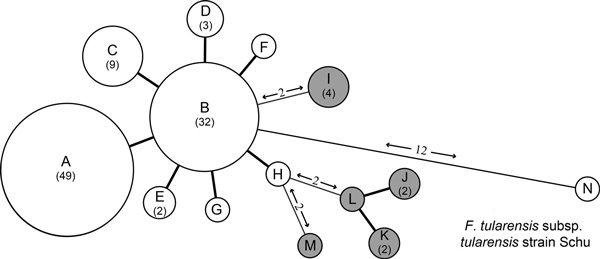Volume 20, Number 5—May 2014
Research
Molecular Investigation of Tularemia Outbreaks, Spain, 1997–2008
Figure 2

Figure 2. Minimum-spanning tree based on multilocus variable number of tandem repeat analysis (MLVA) genotypes, showing genetic relationships among 98 Francisella tularensis subspholarctica isolates from Spain (white circles), 10 Ftularensis subspholarctica reference isolates from the Czech Republic (gray circles), and reference strain Ftularensis subsptularensis Schu (CAPM 5600)Each node represents a unique MLVA type, and size is proportional to the number of isolates with that genotype (values in parentheses)Numbers on lines between nodes indicate number of typing markers that were different between genotypesA 1-marker difference is indicated by a thick line.
Page created: April 16, 2014
Page updated: April 16, 2014
Page reviewed: April 16, 2014
The conclusions, findings, and opinions expressed by authors contributing to this journal do not necessarily reflect the official position of the U.S. Department of Health and Human Services, the Public Health Service, the Centers for Disease Control and Prevention, or the authors' affiliated institutions. Use of trade names is for identification only and does not imply endorsement by any of the groups named above.